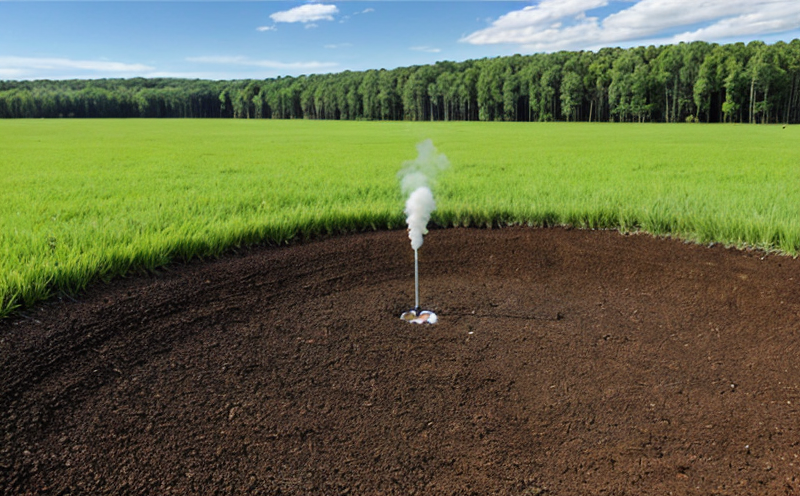DIN 19745 Soil Leachability for Pollutants Testing
The DIN 19745 soil leachability test is a fundamental analytical procedure used to assess the potential release of pollutants into the environment from various materials and products. This method, which adheres strictly to international standards such as ISO and ASTM, plays a crucial role in environmental impact testing within the mining sector.
The primary objective of this test is to determine how readily pollutants can be leached out of solid waste or landfilled material into surrounding soil and water systems. By quantifying these potential releases early in the product lifecycle, industries like mining can proactively manage their environmental footprint and comply with stringent regulatory requirements.
The testing procedure involves carefully controlled conditions that simulate real-world scenarios where pollutants might interact with soil over time. The process begins by preparing a composite sample of the material under test (MUT). This sample is then placed in a leaching column filled with deionized water, which simulates natural rainfall and groundwater. Over several days or weeks, depending on the specific protocol, the water percolates through the MUT, extracting any soluble pollutants present.
The extracted solution is collected periodically for analysis using various analytical techniques such as ICP-MS (Inductively Coupled Plasma Mass Spectrometry), GC-MS (Gas Chromatography-Mass Spectrometry), or HPLC (High Performance Liquid Chromatography). These advanced methods provide precise measurements of the concentration levels of different pollutants.
The results help stakeholders understand not only the immediate risks but also predict long-term impacts on local ecosystems. Compliance officers and R&D engineers use these insights to refine processes, select safer materials, or implement mitigation strategies that reduce environmental harm.
Accurate testing is critical because even minute concentrations of certain pollutants can have significant ecological effects. For instance, heavy metals like lead, cadmium, or arsenic are particularly harmful if they enter waterways through soil leaching. By identifying these risks early on, mining companies can take preventive measures to protect both human health and the environment.
| Parameter | Description |
|---|---|
| MUT Composition | Types of materials tested, including tailings, rock waste, or other by-products. |
| Leachate Collection | Methodology for collecting and preserving leachate samples. |
| Water Source | Purified water used to simulate natural conditions accurately. |
| Temperature Control | Regulation of temperature to reflect real-world environmental variables. |
Why It Matters
The significance of DIN 19745 testing cannot be overstated, especially in the mining industry where large volumes of waste are generated during operations. Ensuring that this waste does not contaminate surrounding soils and water sources is essential for sustainable development.
From an operational perspective, accurate leachability tests provide valuable data to support decision-making processes regarding material selection, process optimization, and waste management practices. Compliance officers rely on these results to ensure adherence to local and international environmental regulations.
In the broader context of corporate social responsibility (CSR), conducting thorough soil leachability testing demonstrates a company's commitment to minimizing its ecological footprint. This proactive approach fosters trust among stakeholders, including communities living near mining sites and regulatory bodies responsible for enforcing environmental laws.
Competitive Advantage and Market Impact
In today’s competitive market environment, companies that can demonstrate their commitment to sustainable practices often gain significant advantages. For mining firms, achieving compliance with rigorous testing protocols like DIN 19745 not only ensures regulatory adherence but also enhances brand reputation.
Market demand for environmentally friendly products and services continues to grow globally. Companies that prioritize environmental protection by investing in advanced testing technologies and methodologies are better positioned to meet these demands. This proactive stance can lead to increased market share, customer loyalty, and long-term profitability.
Use Cases and Application Examples
| Scenario | Description |
|---|---|
| Waste Disposal Site Evaluation | Evaluating the potential for pollutants to leach from a proposed waste disposal site. |
| New Material Development | Determining the leachability of newly developed materials used in mining processes. |
| Tailings Management Optimization | Identifying ways to minimize pollutant release from tailings storage facilities. |
| Emission Control System Evaluation | Assessing the effectiveness of emission control systems in preventing pollutants from reaching soils. |
In practice, many mining companies employ DIN 19745 testing to evaluate new materials and processes before they are implemented. This allows them to make informed decisions about which technologies or practices will have the least impact on the environment while still meeting production goals.





